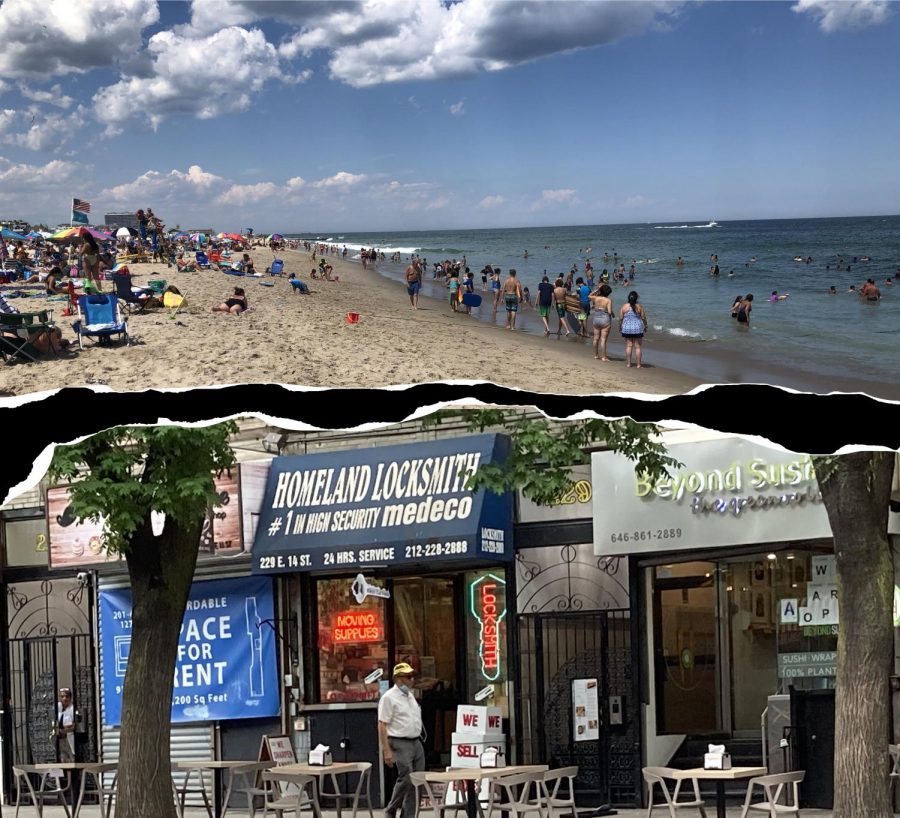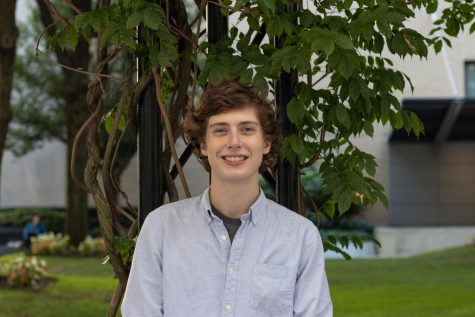New York Has Slowed the Coronavirus, But Can Other States Follow Suit?
COVID-19 cases spike nationwide, prompting fears of a resurgence
PHOTOS BY ANDREW DRESSNER AND ESMÉ BLEECKER-ADAMS; PHOTO ILLUSTRATION BY ESMÉ BLEECKER-ADAMS
While some states are experiencing slowed rates of new cases, some states are experiencing spikes as they begin to reopen.
June 28, 2020
After months of social distancing, states across the nation are beginning to ease the guidelines set up to prevent the spread of COVID-19. But with cases continuing to spike nationwide, many across the nation are forced to reckon with the fact that the battle with coronavirus may drag on longer than previously hoped.
The White House is currently advising states to reopen only after a decline of cases over a 14-day period. However, states such as Florida, Georgia, Missouri and Arizona, to name a few, are relaxing or outright ending their social distancing policies — regardless of the fact that many states, including those previously mentioned, are still reporting a surge in cases.
“Until recently, the New York metro area was the eastern epicenter of infection,” said Robert Madden, Ph.D., and a natural sciences professor at Fordham University. Since the outbreak began in New York, Madden has been tracking infection rates in Westchester County, situated just north of the Bronx within the Hudson Valley.
However, the epicenter of the virus in the United States is now shifting to other states. The continued rise in cases in certain states has already detrimentally affected their testing and hospitalization capabilities; Arizona has been overwhelmed with exponentially increasing cases, as well as a shortage of testing kits. In Texas, another state experiencing a rapid rise in cases, Gov. Greg Abbott has paused his state’s reopening process entirely.
Many of these states feel pressured to reopen in order to recover from the economic downturn spurred by the pandemic, which has particularly had detrimental effects on states that rely on the service industry during the summer months. One such state, Florida, entered its Phase 2 on June 5, despite seeing a surge in new cases. Florida Gov. Rob DeSantis has still refused to implement or reinstate any more restrictions, and has even been accused of coercing scientists to downplay the reported surge of cases within the state.
With this dramatic resurgence, in spite of months of social distancing measures nationwide, scientists, officials and citizens alike are now concerned about a “second wave” or a resurgence of the coronavirus on par with the initial outbreak.
New York’s “Considerable Success”
Many states are using a multistage process to slowly and safely reopen. New York state, which was the original epicenter of COVID-19 in the United States, has experienced a steady decline in its rates of infection, prompting Gov. Andrew Cuomo to begin reopening the state. New York City entered Phase Two of its reopening process on June 22. Other regions of New York state have already been in Phase Three since mid-June.
However, the coronavirus has affected no place more than nursing homes. Even New York has struggled to prevent the disease from ravaging nursing homes and long-term care facilities, with Gov. Cuomo being accused of forcing long-term care facilities to take in patients recovering from the coronavirus, further spreading the risk of transmission amongst an already vulnerable population.
According to Madden, New York’s relative success handling the virus has now been mitigated by the surge in cases in other parts of the country. “The NY metro area, and the northeast in general have had considerable success in reducing their rates of infection through social distancing and other measures, while other areas of the country are experiencing sharp increases, so now the concern has to be more about travel from these areas, such as Texas and Florida to New York,” Madden said.
Reasons Behind States’ Surge
One important factor contributing to this rise, according to Madden, is the easing of the restrictions put in place to slow the coronavirus spread in the first place. “The understandable desire to return to a more normal life means that social distancing is being relaxed. As people come into greater contact with each other, the virus has new opportunities to spread,” he said.
To Madden, fears of a second wave are very much warranted. The level of infectiousness of the coronavirus that epidemiologists use, called a R0 score, is estimated to be around 2.5, according to Madden. “As a comparison, for example, a typical flu has an R0 of about 1.3,” he continued, demonstrating the increased infectivity of COVID-19.
One factor that has made containment of the outbreak difficult is the coronavirus’s infectiousness even when symptoms aren’t necessarily present. “We are learning that an individual can be infected, and asymptomatic or minimally symptomatic, and yet be able to spread the virus,” Madden said. This only increases the virus’s infectiousness, making it all the harder to contain.
However, curbing the coronavirus can still be done adequately. According to Madden, states should invest more in contact tracing, increasing the number of available testing kits and successfully isolating infected individuals. “The idea is to catch infected individuals as soon as possible, to locate the individuals they came in contact with and who therefore might themselves be infected, and to isolate these people … so they don’t further spread the virus,” he said.
Government Action and Inaction
Unfortunately, there have been many failings on the part of both local and federal governments to insure that these criteria are met. The Federal Emergency Management Agency (FEMA) recently began investigating a $10 million contract it signed with a Texan manufacturing company after the millions of testing kits it produced were found to be made of plastic containers meant for soda bottles rather than the standard glass vials.
For New York, the resurgence of the virus across the nation has prompted the state to enact travel restrictions against people coming from any states with a 10% or higher test positivity rate, meaning that at least 10 out of a given state’s 100,000 residents have tested positive for the virus. New Jersey and Connecticut have also followed suit and are implementing similar restrictions.
Regardless, New York state continues to slowly reopen. Already, several regions within the state have entered Phase Three. Madden said that New York state will keep some restrictions in place in order to safely reopen while preventing a second wave from overwhelming the state. “The main efforts being taken by both the city and state to prevent a second wave are to maintain social distancing to the extent possible consistent with allowing at least certain activities to resume,” he said. Such activities that are slowly being reopened include offices, retail stores, restaurants and schools.
For Madden, at least local travel within the tri-state area is much safer now than it was in the spring. “In general, the northeast region of the US has been experiencing declining infection rates, so I wouldn’t expect travel from nearby states, particularly commuting from New Jersey and Connecticut, to pose a threat to us,” Madden said.











